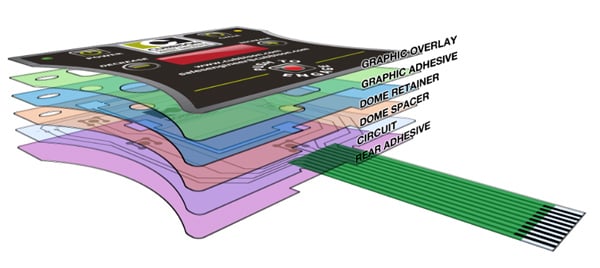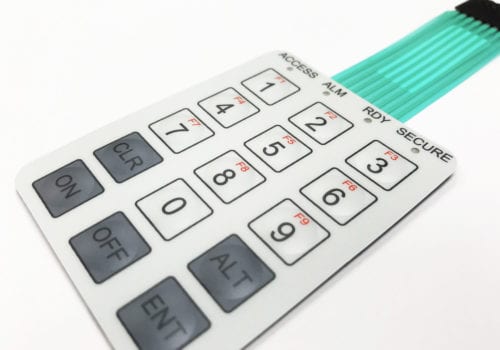How Membrane Switches Are Used to Improve Safety and Functionality in Machinery
How Membrane Switches Are Used to Improve Safety and Functionality in Machinery
Blog Article
Why Membrane Switches Over Are Essential for Resilient Control Systems
Membrane layer buttons play a crucial duty in guaranteeing the resilience and integrity of control systems across various sectors. As we check out the complex advantages of membrane buttons, it ends up being obvious that their significance goes beyond mere capability, influencing individual experience and functional performance.
Review of Membrane Switches
Membrane layer buttons are versatile and dependable elements frequently made use of in numerous digital control systems. These buttons include numerous layers, consisting of a visuals overlay, a spacer layer, and a printed circuit layer. The visuals overlay provides both useful and aesthetic design, while the spacer layer guarantees that the buttons are activated only when pushed. The printed circuit layer includes conductive traces that finish an electrical circuit when the membrane layer is pressed, making it possible for the gadget to react to customer inputs.
Membrane buttons are often favored in applications needing a compact and lightweight style, making them optimal for handheld devices, medical devices, and industrial machinery. They can be tailored to meet specific customer requirements and can integrate numerous features such as backlighting, tactile responses, and several shades. Additionally, membrane switches are immune to dirt, dampness, and impurities, making them appropriate for environments where durability is necessary.
Benefits of Resilience
In several applications, the toughness of membrane layer changes offers substantial advantages that enhance their overall performance and dependability. These buttons are designed to stand up to severe environments, making them ideal for usage popular problems such as high humidity, extreme temperatures, and exposure to chemicals. Their robust building and construction assists to stop damages from physical impact, ensuring resilient functionality and reducing the need for regular substitutes.
Additionally, membrane layer switches are resistant to use and tear, which is vital in applications where frequent communication takes place. This durability equates to decrease maintenance costs, as companies gain from reduced downtime and less solution interruptions. The encapsulated layout of membrane switches protects internal elements from dirt and dampness ingress, more contributing to their life-span (membrane switch).
One more advantage is their capability to preserve constant performance gradually. With a high tolerance for mechanical tension, these switches maintain their responsive feedback and electric honesty, making certain user contentment. Eventually, the durability of membrane layer switches over not only boosts functional performance but likewise cultivates self-confidence in their dependability, making them a preferred option for control systems across numerous fields.
Applications in Numerous Industries
Sturdy control systems using membrane layer switches discover extensive applications throughout a variety of markets, each gaining from the one-of-a-kind characteristics these switches supply. In the medical industry, membrane buttons are vital for devices such as client monitors and diagnostic equipment, where reliability and convenience of cleaning are extremely important. Their resistance to moisture and impurities ensures they preserve functionality in sterilized settings.
The vehicle industry leverages membrane layer buttons for control panel controls and infotainment systems, where they supply smooth, low-profile interfaces that boost individual experience. These switches are additionally created to stand up to extreme problems, consisting of direct exposure to severe company website temperatures and vibrations.
In industrial settings, membrane layer buttons are commonly made use of in machinery control board, offering responsive comments and toughness essential for high-usage applications. Their capability to withstand chemicals makes them ideal for producing environments where spills and contaminants are frequent.

Customer electronics, such as cooking area appliances and push-button controls, additionally use membrane layer buttons for their adaptability and cost-effectiveness. In general, the flexibility and robust nature of membrane switches make them crucial across different sectors, guaranteeing reliable operation and durability in control systems.
Design and Aesthetic Allure
While capability is extremely important, the design and visual appeal of control systems outfitted with membrane switches play a vital function in user interaction and total experience (membrane switch). The visual design of these buttons can substantially influence customer assumption and interaction. A well-designed membrane switch enhances the good looks of the tool, making it more enticing to customers and promoting a connection between the customer and the product
Membrane changes provide a large amount of adaptability in layout, permitting suppliers to customize graphics, colors, and textures content to line up with brand name identity and item aesthetic appeals. The use of lively shades and distinctive patterns can draw interest, while tactile comments can enhance the user's interaction with the tool. In addition, the capability to integrate LED indicators and backlighting right into the membrane layer button design offers both practical and aesthetic benefits, enhancing visibility and usability in various environments.

Enhancing Individual Experience

Furthermore, membrane buttons can be customized to incorporate visual interfaces, boosting use by providing info in a clear and intuitive way (membrane switch). This personalization can include icons, labels, and color coding that overview individuals with complex functionalities easily. In addition, their convenience enables assimilation in different environments, making sure constant performance whether in industrial equipment or customer electronic devices
The durability of membrane buttons additionally plays a vital duty in individual experience. By enduring harsh conditions and extended use, these buttons reduce the possibility of system failings, hence promoting reliability and user self-confidence. Eventually, the tactical use membrane switches not just boosts performance however likewise substantially improves individual interaction with control systems, making them an indispensable component in modern-day design.
Conclusion

Report this page